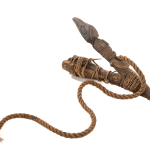-
Artworks
UNIDENTIFIED TLINGIT MAKER
Halibut Hook, late 19th centurythe halibut hook: wood, spruce root, cedar rope, and plant fibre cording [?], 9 x 4.25 x 2 in (22.9 x 10.8 x 5.1 cm), measurements reflect dimensions without ropeLOT 10
ESTIMATE: $800 — $1,200
PRICE REALIZED: $793.00Further images
Tlingit two-piece halibut hooks are a wonder of Indigenous engineering. To make these, two pieces of wood of different types are hafted together in a V or Y-shape with one...Tlingit two-piece halibut hooks are a wonder of Indigenous engineering. To make these, two pieces of wood of different types are hafted together in a V or Y-shape with one side carved into a figure. A barb is added at an angle to the side opposite the carving and is baited by tying a squid or piece of fish with twine to the barb. The aperture of the hook may be adjusted to target different sizes of halibut by sliding the point of the barb further into or out of the hook. The hook is then tied to a ground line and a series of floats and thrown overboard, the different densities of the two wood pieces creating a buoyancy that allows the hook to float up from the seafloor, carving side down. Usage of the hooks wears them down over time, resulting in a loss of wood where the halibut strike, which can impact the buoyancy of the hook. In some instances, fishermen would tie additional wood pieces to the hook to increase the buoyancy instead of completely replacing it, as can be seen on this example. There has been a revival of the usage of these customary hooks in Tlingit and Haida communities in Southeastern Alaska in the last ten years.
This older hook features a raven and is unusual for still having all the twine, rope, and gear still attached to it. It has clearly seen a lot of usage over the years and has several wooden floats attached to modify its balance and increase buoyancy in the water.
Christopher W. Smith
Provenance
Important Private Collection, Pittsburgh, PA.
Join our mailing list
* denotes required fields
We will process the personal data you have supplied in accordance with our privacy policy (available on request). You can unsubscribe or change your preferences at any time by clicking the link in our emails.








